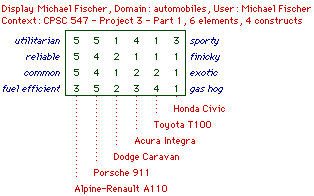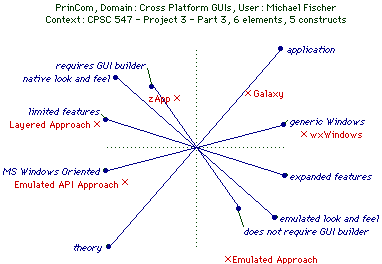CPSC 547 Project 3 - WebGrid
By: Michael
Fischer
1. Exploration
Description of the grid created
When exploring anything, people tend to use examples and topics which interest them. Whilest exploring the WebGrid system of automated Personal Construct Psychology, I followed this same trend. I decided to base my experimentally created grid on automobiles.
During this exploration, WebGrid requires several elements, concrete examples,
of items. For these I choose several existing automobiles. During early playing with WebGrid, I noticed that elements should be varied of obvious different types, in order to facilitate creation of constructs for these elements. With this in mind, I choose a range of automobiles from the esoteric Alpine-Renault A110 to the common
Honda Civic.
These varied elements, allowed several good constructs to be created. A constrct is basically a rateable description on a element. For example, one construct I used was exotic (and it's opposite - common.) Obviously, the A110 would
rate much higher on the exotic scale then the Civic would.

Examine the Automobile Grid
Comments on initial impressions
Whilest attempting to access WebGrid, I noticed several things. Primarily, I found WebGrid cumbersome and confusing to use. Though eliciting a grid via WebGrid requires several steps, these steps did not appear well defined, or procedurally executed. Leaping amongst constructs to elements and back, it was easy to
misinterpret intermediate results.
Since many people are not familiar with Personal Contruct Psychology grids, a
Help feature which explained these grids and individual sections of WebGrid
should be included in future versions of WebGrid.
An impression of WebGrid, especially related to its relevance as a CPSC 547
assignment topic, was that it appeared to be someone's pet project, of dubious
value, enforced upon students, who, if they wanted a course if '50's psychology,
could watch any army training film.
2. Elicitation of constructs on CPSC547 topics
Description of the grid
This grid uses the various presentation topics discussed in Mildred Shaw's Computer Science 547 class as elements. These "Advanced Information Systems" topics display a varying range, from purely technological topics to ethical questions. These same elements we used by both Brian Gaines and myself, in an attempt to discover if we think of things similarly.
The constructs used in this grid composed two sets. Brian Gaines generated a complete grid with a set of constructs he developed. I was kept unaware of the constructs he had used, until the comparision phase.
I generated another set of contructs based upon my experiences with the topic elements. As stated before, some of the elements fell into a purely technological realm, whereas other were more social issues, most topics fell somewhere between these poles. Knowing this, I was able to create a few construct based directly upon this fact.
Not every element couple be easily pigeon-holed using this method. Therefore, WebGrid provides a construct-developing aid, Triad. This Triad presents three elements and enlists the user to specify which element is different and why, this forms a new construct.
Comparision of the grids

Examine the Aspects of Advanced Information Systems Grid
Comparing the grid and constructs generated by Brian Gaines, with the grid and constructs I generated provides several insights.
Examining the girds shows that one several occasions, we showed correspondence in our terminology. For example, Gaines tended to us the term 'development tool' whereas I preferred the term 'programming tool'; obviously a small difference in terms, yet we both tended to rank elements the same along this construct.
Similarly, we tended to show a great deal of correspondence in other constructs. Gaines tended to use only 'applicatiom' or 'development tool' for all his constructs, whereas I showed a larger vocabulary in constructs.
On a couple of occasions, myself abnd Gaines were at conflict, we used similar terminology but with fundamentally opposite distinctions. Specifically regarding 'Knowledge-based Systems', Gaines indicated this was a 'development tool' whilest I disagreed with that.
Recall that this comparision is only valid within the domain of 'Advanced Information Systems Topics.' It in no way implies Gaines and I think similarly on any other topic.
3. Elicitation of constructs on Cross Platform GUIs
Description of the grid
As with all WebGird grids, two sections are required, the elements and the constructs. For the
elements, I choose to use a combination of theory elements and application elements. This was used inorder to use WebGrid to determine which applications seemed to follow which theory, via the use of constructs.
Constructs are typically more difficult to create then elements. To create these constructs, I used the Triad method. This method allowed constructs to be developed by a process of exclusion.

Examine the Cross Platform GUI Grid
Analysis of the grid - PrinCom

PrinCom allows us to break the grid into principle components. This breakage allows us to see that the 'Layered Approach' is the antithesis of 'expanded features' and that it requires a 'GUI builder', but 'maintains native look and feel'.
Similarly, we can see that 'zApp' , 'Galaxy' and 'wxWindows' are all applications, yet 'Galaxy' and 'wxWindows' tend to be more similar applications.
Oppositely, we can see that the 'Emulated API Approach' is a Microsoft Windows oriented theory, without a related application of this theory.
Analysis of the grid - Focus

Focus allows us to see that that constructs of 'emulated look and feel' often occur with 'expanded features.' This is quite logical, since Emulated Look and Feel systems control the entire GUI, thus they can produce whatever features they wish.
Similarly, 'emulated look and feel' systems appeared to be more geared (or can be) more towards 'generic' windowing systems, rather then Microsoft Windows.
Few other contructs display much relationship amongst them.
Examing the elements tells us that wxWindows and Galaxy, two applications of PIGUI technology' are similar. Additionally, both of these two applications can be viewed are implementation of the Emulated Approach to Cross Platform GUI systems.
Surprisingly, Focus tells us that the 'Emulated API Approach' and the 'Layered Approach' are
somewhat related. Initially, this seems incorrect, shouldn't the 'Emulated API Approach' and
the 'Emulated Approach' be more similar? No, Focus is correct; both the 'Layered Approach' and the 'Emulated API Approach' abstract the GUI away from the target system, and rely upon a
third-party intermediary to provide the actual GUI executable. Here Focus has provided use with useful information which may have been overlooked.
Further Information on
Cross Platform GUIs
Last Updated March 24,1996 by fischer@cpsc.ucalgary.ca







